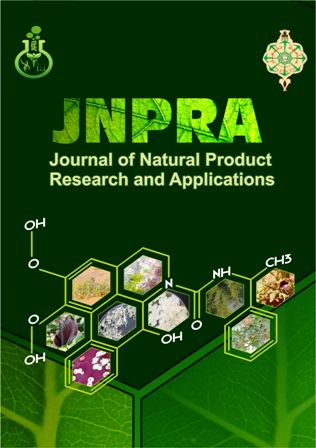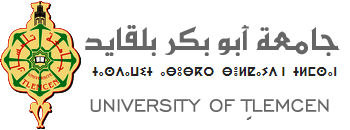Evaluation of the nutritional value and antioxidant activity of Opuntia ficus indica seeds in the western region of Algeria
DOI:
https://doi.org/10.46325/jnpra.v2i1.41Keywords:
Opuntia ficus indica, seeds, oil, nutritive value, antioxidant activity.Abstract
The Opuntia ficus indica (OFI), commonly known as "prickly pear" is a Cactaceae native to Central America that is well suited to arid and semi-arid areas such as Algeria. In recent decades, interest in this long-ignored cactus has increased. Different parts including (cladodes, fruits, flowers) of this plant have been studied, but little work has been devoted to the seeds, which are considered as by-products. It is in this context our research was conducted, it aimed to establish the nutritive value and antioxidant power of these seeds. The study of seed composition showed high crude fiber content estimated at 71.91% and significant levels of fat and protein 10.19% and 9.19%, respectively. The best oil yield was obtained after 8-hour of oil extraction. Given that its density and refractive index were calculated to be 0.916 and 1.470, respectively, this oil is of higher grade. The saponification and acidity were in the range of 161.31 and 1.74, respectively. The total polyphenols were about 1.110 mg EQG / g of DW. The antioxidant activity was revealed by the DPPH free radicals scavenging method. The obtained results were assigned the highest antioxidant activity with flavonoids over 90% at a concentration of 0.5 mg / mL for both fractions (acetate and n -butanol), their EC 50 values are about of 0.089 mg / mL and 0.063 mg / mL, respectively, the latters are close to the EC 50 of ascorbic acid. Thus, OFI seeds may be of interest to the cosmetics industry for its beneficial properties.
References
AOAC (1990). Official Methods of Analysis. 15th ed, Washington, DC: Association of Official Analytical Chemists.
AOAC (1995). Official Method of Analysis of the Association of Official Analytical Chemist. 16th Ed, Association of Official Analytical Chemists, Washington, DC, USA
Arba, M. (2009). Le cactus opuntia une espèce fruitière et fourragère pour une agriculture durable au Maroc. In Actes du Symposium International AGDUMED-durabilité des systèmes de culture en zone méditerranéenne et gestion des ressources en eau et en sol (pp. 14-16). Rabat: Cana Print.
Ardestani A. & Yazdanparast R., (2007). Antioxidant and free radical scavenging potential of Achillea santolina extracts. Food Chemistry, 104(1): 21-29. https://doi.org/10.1016/ j.foodchem.2006.10.066
Bekkara, F., Jay, M., Viricel, M. R., & Rome, S. (1998). Distribution of phenolic compounds within seed and seedlings of two Vicia faba cvs differing in their seed tannin content, and study of their seed and root phenolic exudations. Plant and Soil, 203(1), 27-36. https://doi.org/10.1023/A:1004365913726
Blahová, E., Brandšteterová, E., & Fabulová, A. (2004). Isolation and determination of phenolic compounds in fruit green tea. Journal of Liquid Chromatography and Related Technologies, 27(1), 31-48. https://doi.org/10.1081/JLC-120027084
Boukeloua, A., Belkhiri, A., Djerrou, Z., Bahri, L., Boulebda, N., & Pacha, Y. H. (2012). Acute toxicity of Opuntia ficus indica and Pistacia lentiscus seed oils in mice. African Journal of Traditional, Complementary and Alternative Medicines, 9(4), 607-611. http://dx.doi.org/10.4314/ajtcam.v9i4.19
Brune, M., Hallberg, L., & Skånberg, A. B. (1991). Determination of iron‐binding phenolic groups in foods. Journal of Food Science, 56(1), 128-131. https://doi.org/10.1111/j.1365-2621.1991.tb07992.x
Bruneton, J. (1999). Toxic plants: dangerous to humans and animals. Intercept Limited. Springer
Cardador-Martínez, A., Jiménez-Martínez, C., & Sandoval, G. (2011). Revalorization of cactus pear (Opuntia spp.) wastes as a source of antioxidants. Food Science and Technology, 31, 782-788. https://doi.org/10.1590/S0101-20612011000300036
Cartea, M. E., Francisco, M., Soengas, P., & Velasco, P. (2010). Phenolic compounds in Brassica vegetables. Molecules, 16(1), 251-280. https://doi.org/10.3390/molecules16010251
Chbani, M., Matthäus, B., Charrouf, Z., El Monfalouti, H., Kartah, B., Gharby, S., & Willenberg, I. (2020). Characterization of phenolic compounds extracted from cold pressed cactus (Opuntia ficus-indica L.) seed oil and the effect of roasting on their composition. Foods, 9(8), 1098. https://doi.org/10.3390/foods9081098
Chougui, N., Tamendjari, A., Hamidj, W., Hallal, S., Barras, A., Richard, T., & Larbat, R. (2013). Oil composition and characterisation of phenolic compounds of Opuntia ficus-indica seeds. Food Chemistry, 139(1-4), 796-803. https://doi.org/10.1016/ j.foodchem.2013.01.054
Coşkuner, Y. N., & Tekin, A. (2003). Monitoring of seed composition of prickly pear (Opuntia ficus indica L) fruits during maturation period. Journal of the Science of Food and Agriculture, 83(8), 846-849. https://doi.org/10.1002/jsfa.1423
de Wit, M., du Toit, A., Osthoff, G., & Hugo, A. (2019). Cactus pear antioxidants: A comparison between fruit pulp, fruit peel, fruit seeds and cladodes of eight different cactus pear cultivars (Opuntia ficus indica and Opuntia robusta). Journal of Food Measurement and Characterization, 13(3), 2347-2356. https://doi.org/10.1007/s11694-019-00154-z
De Wit, M., Hugo, A., & Shongwe, N. (2017). Quality assessment of seed oil from selected cactus pear cultivars (Opuntia ficus indica and Opuntia robusta). Journal of Food Processing and Preservation, 41(3), e12898. https://doi.org/10.1111/jfpp.12898
Dib, H., Seladji, M., El-Haci, A. I., Benammar, C., & Meriema, B. M. B. (2021). Phytochemical screening and Antioxidant activity of Opuntia ficus indica seeds from Algeria. Arabian Journal of Medicinal and Aromatic Plants, 7(3), 352-366. https://doi.org/10.48347/IMIST.PRSM/ajmap-v7i3.28409
Djeridane, A., Yousfi, M., Nadjemi, B., Boutassouna, D., Stocker, P., & Vidal, N. (2006). Antioxidant activity of some Algerian medicinal plants extracts containing phenolic compounds. Food Chemistry, 97(4), 654-660. https://doi.org/10.1016/j.foodchem.
04.028
Dubois M., Gilles K. A., Hamilton J. K., Rebers P. T. & Smith, F. (1956). Colorimetric method for determination of sugars and related substances. Analytical Chemistry, 28(3): 350-356.
El Mannoubi, I., Barrek, S., Skanji, T., Casabianca, H., & Zarrouk, H. (2009). Characterization of Opuntia ficus indica seed oil from Tunisia. Chemistry of Natural Compounds, 45(5), 616-620. https://doi.org/10.1007/s10600-009-9448-1
El Mannoubi, I., Barrek, S., Skanji, T., & Zarrouk, H. (2007). Etude de la composition chimique des graines du figuier de barbarie (Opuntia ficus indica). Revue des régions arides, 124-130.
EL Kossori, E., Lamghari, R., Villaume, C., El Boustani, E., Sauvaire, Y., & Méjean, L. (1998). Composition of pulp, skin and seeds of prickly pears fruit (Opuntia ficus indica sp.). Plant Foods for Human Nutrition, 52(3), 263-270. https://doi.org/10.1023/A:1008000232406
El-Mostafa, K., El Kharrassi, Y., Badreddine, A., Andreoletti, P., Vamecq, J., El Kebbaj, M. H. S., Latruffe N., Lizard G., Nasser B. & Cherkaoui-Malki, M. (2014). Nopal cactus (Opuntia ficus-indica) as a source of bioactive compounds for nutrition, health and disease. Molecules, 19(9), 14879-14901. https://doi: 10.3390/molecules190914879.
Ennouri, M., Evelyne, B., Laurence, M., & Hamadi, A. (2005). Fatty acid composition and rheological behaviour of prickly pear seed oils. Food Chemistry, 93(3), 431-437. https://doi.org/10.1016/j.foodchem.2004.10.020
Ennouri, M., Fetoui, H., Bourret, E., Zeghal, N., & Attia, H. (2006). Evaluation of some biological parameters of Opuntia ficus indica. 1. Influence of a seed oil supplemented diet on rats. Bioresource Technology, 97(12), 1382-1386. https://doi.org/10.1016/ j.biortech.2005.07.010
Ennouri, M., Fetoui, H., Bourret, E., Zeghal, N., Guermazi, F., & Attia, H. (2006). Evaluation of some biological parameters of Opuntia ficus indica. 2. Influence of seed supplemented diet on rats. Bioresource Technology, 97(16), 2136-2140. https://doi.org/10.1016/j.biortech.2005.09.031
Filip, S., Hribar, J., & Vidrih, R. (2011). Influence of natural antioxidants on the formation of trans‐fatty‐acid isomers during heat treatment of sunflower oil. European Journal of Lipid Science and Technology, 113(2), 224-230. https://doi.org/10.1002/ejlt.200900231
Ghazi, Z., Ramdani, M., Tahri, M., Rmili, R., Elmsellem, H., El Mahi, B., & Fauconnier, M.L. (2015). Chemical composition and antioxidant activity of seeds oils and fruit juice of Opuntia Ficus Indica and Opuntia Dillenii from Morocco. Journal of Materials and Environmental, 6, 2338–2345. https://hdl.handle.net/2268/189343
Harborne, J.B. (1973). Phenolic Compounds. In: Phytochemical Methods. Springer, Dordrecht. https://doi.org/10.1007/978-94-009-5921-7_2
Hayouni, E. A., Abedrabba, M., Bouix, M., & Hamdi, M. (2007). The effects of solvents and extraction method on the phenolic contents and biological activities in vitro of Tunisian Quercus coccifera L. and Juniperus phoenicea L. fruit extracts. Food Chemistry, 105(3), 1126-1134. https://doi.org/10.1016/j.foodchem.2007.02.010
ISO 659, International Organization for Standardization (1988).
Julkunen-Tiitto, R. (1985). Phenolic constituents in the leaves of northern willows: methods for the analysis of certain phenolics. Journal of Agricultural and Food Chemistry, 33(2), 213-217. https://doi.org/10.1021/jf00062a013
Kennedy, J. A., Troup, G. J., Pilbrow, J. R., Hutton, D. R., Hewitt, D., Hunter, C. R., Ristic R., Iland P. G. & Jones, G. P. (2000). Development of seed polyphenols in berries from Vitis vinifera L. cv. Shiraz. Australian Journal of Grape and Wine Research, 6(3), 244-254. https://doi.org/10.1111/j.1755-0238.2000.tb00185.x
Kolniak-Ostek, J., Kita, A., Miedzianka, J., Andreu-Coll, L., Legua, P., & Hernandez, F. (2020). Characterization of bioactive compounds of Opuntia ficus-indica (L.) Mill. seeds from Spanish Cultivars. Molecules, 25(23), 5734. https://doi.org/10.3390/ molecules25235734
Labuschagne, M. T., & Hugo, A. (2010). Oil content and fatty acid composition of cactus pear seed compared with cotton and grape seed. Journal of Food Biochemistry, 34(1), 93-100. https://doi.org/10.1111/j.1745-4514.2009.00266.x
Loizzo, M. R., Bruno, M., Balzano, M., Giardinieri, A., Pacetti, D., Frega, N. G., Sicari V., Leporini M., & Tundis, R. (2019). Comparative chemical composition and bioactivity of Opuntia ficus indica Sanguigna and Surfarina seed oils obtained by traditional and ultrasound‐assisted extraction procedures. European Journal of Lipid Science and Technology, 121(1), 1800283. https://doi.org/10.1002/ejlt.201800283
Matthäus, B., & Özcan, M. M. (2006). Quantitation of Fatty Acids, Sterols, and Tocopherols in Turpentine (Pistacia terebinthu s Chia) Growing Wild in Turkey. Journal of Agricultural and Food Chemistry, 54(20), 7667-7671. https://doi.org/10.1021/jf060990t
Matthäus, B., & Özcan, M. M. (2011). Habitat effects on yield, fatty acid composition and tocopherol contents of prickly pear (Opuntia ficus indica L.) seed oils. Scientia Horticulturae, 131, 95-98. https://doi.org/10.1016/j.scienta.2011.09.027
Mole, S., & Waterman, P. G. (1987). A critical analysis of techniques for measuring tannins in ecological studies. Oecologia, 72(1), 137-147. https://doi.org/10.1007/BF00385058
Mulas, M., and Mulas, G. (2004). The strategic use of Atriplex and Opuntia to combat desertification. Sassari, Italia: Desertification Research Group, University of Sassari.
Nounah, I., Gharby, S., Hajib, A., Harhar, H., Matthäus, B., & Charrouf, Z. (2021). Effect of seeds roasting time on physicochemical properties, oxidative stability, and antioxidant activity of cactus (Opuntia ficus indica L.) seed oil. Journal of Food Processing and Preservation, 45(9), e15747. https://doi.org/10.1111/jfpp.15747
Ollë, M. (2002). Direction de la concurrence, de la consommation et de répression des fraudes interrégionales de Montpellier. Dossier P3325, Technique d’analyse.
Ortega-Ortega, M. D. L. A., Cruz-Cansino, N. D. S., Alanís-García, E., Delgado-Olivares, L., Ariza-Ortega, J. A., Ramírez-Moreno, E., & Manríquez-Torres, J. D. J. (2017). Optimization of ultrasound extraction of cactus pear (Opuntia ficus indica) seed oil based on antioxidant activity and evaluation of its antimicrobial activity. Journal of Food Quality. https://doi.org/10.1155/2017/9315360
Özcan, M. M., & Al Juhaimi, F. Y. (2011). Nutritive value and chemical composition of prickly pear seeds (Opuntia ficus indica L.) growing in Turkey. International journal of food sciences and nutrition, 62(5), 533-536. https://doi.org/10.3109/09637486.2011.552569
Ramadan, M. F., and Moersel, J. T. (2006). Screening of the antiradical action of vegetable oils. Journal of Food Composition and Analysis, 19(8), 838-842. https://doi.org/ 10.1016/j.jfca.2006.02.013
Ramadan, M. F., & Mörsel, J. T. (2003). Recovered lipids from prickly pear [Opuntia ficus-indica (L.) Mill] peel: a good source of polyunsaturated fatty acids, natural antioxidant vitamins and sterols. Food Chemistry, 83(3), 447-456. https://doi.org/10.1016/S0308-8146(03)00128-6
Sánchez‐Moreno, C., Larrauri, J. A., & Saura- Calixto, F. (1998). A procedure to measure the antiradical efficiency of polyphenols. Journal of the Science of Food and Agriculture, 76(2), 270-276. https://doi.org/10.1002/(SICI)1097-0010(199802)76:2<270::AID-JSFA945>3.0.CO;2-9
Soel, S. M., Choi, O. S., Bang, M. H., Park, J. H. Y., & Kim, W. K. (2007). Influence of conjugated linoleic acid isomers on the metastasis of colon cancer cells in vitro and in vivo. The Journal of Nutritional Biochemistry, 18(10), 650-657. https://doi.org/10.1016/j.jnutbio.2006.10.011
Sofowara, A. (1993). Medicinal plants and traditional medicine in Afric.(3rd Eds). Nigeria: Spectrum Books Ltd, 150-153.
Sökmen, B., Aydin, S., & Kinalioğlu, K. (2012). Antioxidant and antibacterial properties of a lichen species Diploschistes scruposus (Schreb.) Norman. European Journal of Biology, 71(1), 43-51.
Swain, T., & Hillis, W. E. (1959). The phenolic constituents of Prunus domestica. I. The quantitative analysis of phenolic constituents. Journal of the Science of Food and Agriculture, 10(1), 63-68. https://doi.org/10.1002/jsfa.2740100110
Trease, G. E., & Evans, W. C. (1987). Pharmacognosy, Springer. vol. 5.
Yeddes, N., Chérif, J. K., Jrad, A., Barth, D., & Trabelsi-Ayadi, M. (2012). Supercritical SC-CO2 and soxhlet n-hexane extract of Tunisian Opuntia ficus indica seeds and fatty acids analysis. Journal of Lipids, 2012. https://doi.org/10.1155/2012/914693
Yu, Z., & Dahlgren, R. A. (2000). Evaluation of methods for measuring polyphenols in conifer foliage. Journal of Chemical Ecology, 26(9), 2119-2140. https://doi.org/10.1023 /A:1005568416040
Downloads
Published
Issue
Section
License

This work is licensed under a Creative Commons Attribution-NonCommercial 4.0 International License.






